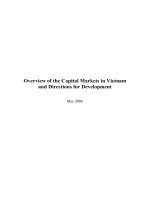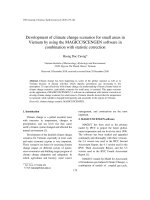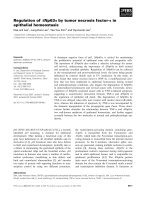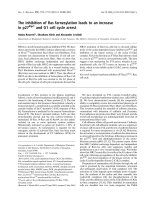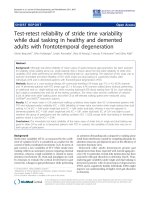Degradation of propanil by Acinetobacter baumannii DT immobilized in alginate
Bạn đang xem bản rút gọn của tài liệu. Xem và tải ngay bản đầy đủ của tài liệu tại đây (1.25 MB, 5 trang )
Physical Sciences | Chemistry
Doi: 10.31276/VJSTE.64(3).08-12
Degradation of propanil by Acinetobacter baumannii DT
immobilized in alginate
Danh Duc Ha*, Thi Oanh Nguyen
Dong Thap University
Received 5 October 2020; accepted 4 January 2021
Abstract:
The herbicide propanil has been widely applied in Vietnam and around the world to control weeds. In this
study, Acinetobacter baumannii DT isolated from soil was used to determine propanil degradation. Degradation
experiments were carried out with condensed cells at 109 CFU/ml with both free and immobilized forms of the
bacteria. Propanil degradation rates by bacteria immobilized in alginate were higher than those of free cells
at the same concentrations. The degradation curve as a function of concentration fit well to the degradation
kinetics described by the Edwards model with a maximum degradation of 0.034±0.003 mM/h for free cells and
0.053±0.005 mM/h for immobilized cells. Moreover, the immobilized bacteria could tolerate higher propanil
concentrations and degrade propanil in a well-known herbicide more effectively compared to the freely
suspended bacteria. These results demonstrate that A. baumannii DT immobilized in alginate is suitable for
degradation of propanil in herbicides.
Keywords: Acinetobacter baumannii DT, degradation, immobilized cells, kinetics, propanil.
Classification number: 2.2
Introduction
The proper use of herbicides in agricultural production
saves money, time and labor, especially considering they
have become indispensable in today’s agricultural sector.
Propanil is a contact herbicide [1], which is used globally.
This herbicide inhibits the photosynthesis of broadleaf weeds
that leads to leaf chlorosis and the subsequent necrosis of
leaves and other organs [2]. The herbicide is mainly applied
to rice fields, which results in surface water, groundwater,
and soil contamination [3-5]. Propanil has been detected
at concentrations up to 3.6 mg/l in water [5], while the
acceptable level of propanil in drinking water is 0.1 μg/l [6].
Propanil is usually mixed with butachlor to increase the
efficiency of weed eradication [7]. The negative effects of
butachlor on soil microorganisms have also been studied
[8-10]. Therefore, the biodegradation of propanil may be
influenced by the presence of butachlor. However, few
reports describing the effects of butachlor on the degradation
of propanil have been published [11].
Alginate is a natural polymer universally employed to
immobilize cells in biodegradation experiments because
alginate is relatively mild, chemically inert, inexpensive,
and non-toxic [12]. Several bacteria and fungi such as
Fusarium oxysporum [13], Paracoccus sp. FLN-7 [14],
Ochrobactrum sp. PP-2 [15], and Spirosoma sordidisoli
TY50T [16] have been isolated. However, to our knowledge,
no publication has yet described the degradation of propanil
by microorganisms immobilized in alginate.
In our previous report, propanil degradation by
A. baumannii DT during the exponential growth phase with
low cell density was determined [11, 17]. In this study,
propanil degradation by A. baumannii DT immobilized in
alginate and condensed counterparts is compared.
Materials and methods
Cultivation media
The mineral medium (MM) used in this study was
prepared according to Ha Danh Duc (2017) [18]. The MM
contained (in grams per liter) Na2HPO4, 2.79; KH2PO4,
1.00; (NH4)2SO4, 1.00; MgSO4·H2O, 0.20; and 1.00 ml of
trace mineral solution. The trace mineral solution consisted
of (in grams per liter) H3BO3, 0.30; CoCl2·6H2O, 0.20;
ZnSO4·7H2O, 0.10; Na2MoO4·2H2O, 0.03; MnCl2·4H2O,
0.03; NiCl2·6H2O, 0.02; and CuCl2·2H2O, 0.01. The pH of
the MM was adjusted to 7.0±0.1. Ammonium sulfate (0.1%,
w/v) and succinate (0.1%, w/v) were supplemented as a
Corresponding author: Email:
*
8
september 2022 • Volume 64 Number 3
Physical sciences | Chemistry
nitrogen and carbon source, respectively. The medium was
sterilized for 15 min at 121°C and stored at 4°C until further
use. Pure propanil (99.6%) and herbicide with the trade
name Cantanil 550EC (Thanhson Agrochem Company,
Vietnam) were used. Cantanil 550EC contained 275 mg/l
of propanil, 275 mg/l of butachlor, and adjuvant was used to
determine the biodegradation of propanil.
For the degradation of propanil in herbicide, Cantanil
550EC was added to 0.1 mM of propanil. The effects of
butachlor on propanil degradation were also carried out.
Pure butachlor or butachlor in the herbicide Cantanil 550EC
were used at the same quantity (weight) as propanil. The
incubation processes were conducted at room temperature
(from 28 to 31oC) with a shaking speed of 150 rpm.
Long-term storage condition
Resting cells and immobilization method
To prepare for immobilization, A. baumannii DT was
cultured in MM amended with ammonium sulfate and
succinate medium for 12 h. Bacteria were collected by
centrifugation at 10,000 rpm for 5 min. Cell pellets were
washed twice with sterile MM. The mixture was then resuspended in MM used for degradation by free cells (resting
cells) while 2×MM was used for immobilization.
For long-term storage, resting and entrapped bacteria
were stored in Corning™ polyethylene terephthalate
centrifuge tubes in the dark at 4oC. After 2 months of storage,
both free and immobilized bacteria were kept at room
temperature for 2 h before determining cell survival and
biodegradation. The results were compared with bacteria
numbers and degradation rates of fresh ones.
The immobilization process was carried out according to
a previous report [19] with modifications. The concentrated
bacterial solution was mixed with a sterilized solution
of Ca-alginate and glycerol to give final cell numbers
of approximately 109 CFUs/ml, 3% alginate, and 10%
glycerol. The solution was carefully blended and dripped
into a solution containing 3% CaCl2 (w/v) using a syringe.
The beads formed in the solution were stirred for 1 h using a
magnetic bar and then stored for 24 h at 4oC in this solution.
The beads were collected and washed twice with MM before
being used in experiments.
The number of viable bacterial cells in an alginate bead
has been described by M. Schoebitz, et al. (2012) [23] with
some modification. The beads (1.0 g) were transferred to 10
ml of sterile sodium citrate (6%, w/v) to dissolve at 30oC on
a rotary shaker for 30 min. Then, the solution was serially
diluted with MM and spread on an agar plate containing
MM supplemented with ammonium sulfate and succinate.
For the enumeration of non-immobilized cells, the bacteria
solution was serially diluted and also spread on the plates.
The number of survival bacteria was determined based on
colonies emerging after being incubated for 24 h at 30oC in
an incubator.
Propanil degradation by resting cells and immobilized
cells
The degradation processes of propanil were carried out
in MM with 109 CFUs/ml of both freely suspended and
immobilized bacteria. Propanil was dissolved in absolute
ethanol at 0.1 M and used as a stock solution. The degradation
was carried out at propanil concentrations ranging from
0.1 to 0.7 mM. The degradation rates at various propanil
concentrations were determined and expressed in mM/h.
Nonlinear regression analysis was used to fit the trends of
the degradation process. The obtained data were best fit by
kinetic models that incorporate the equation for logarithmic
degradation such as the V.H. Edwards model (1970) [20]
given by V=Vmax[e(-S/Ki)‒e(-S/Ki)] or the Haldane equation
[21] V=(VmaxS)/(Ks+S+S2/Ki) where V is the degradation
velocity, Vmax is the maximum degradation rate, S is the
propanil concentration, Ki is the inhibition coefficient, and
Ks is the half-saturation coefficient. The kinetic parameters
were then calculated based on linear regression fitting of
the H. Lineweaver, D. Burk (1934) [22] plot or double
reciprocal plot. The Dixon plot was used to determine the
inhibition constant in which the reciprocal of the velocity
(1/V) was plotted against the inhibitor concentrations [i].
Analytical method
Propanil concentrations were measured using reverse
phase high performance liquid chromatography (HPLC)
(LC-10AD, Shimadzu, Ja����������������������������������������������������������������������������������������������������������������������������������������������������������������������������������������������������������������������������������������������������������������������������������������������������������������������������������������������������������������������������������������������������������������������������������������������������������������������������������������������������������������������������������������������������������������������������������������������������������������������������������������������������������������������������������������������������������������������������������������������������������������������������������������������������������������������������������������������������������������������������������������������������������������������������������������������������������������������������������������������������������������������������������������������������������������������������������������������������������������������������������������������������������������������������������������������������������������������������������������������������������������������������������������������������������������������������������������������������������������������������������������������������������������������������������������������������������������������������������������������������������������������������������������������������������������������������������������������������������������������������������������������������������������������������������������������������������������������������������������������������������������������������������������������������������������������������������������������������������������������������������������������������������������������������������������������������������������������������������������������������������������������������������������������������������������������������������������������������������������������������������������������������������������������������������������������������������������������������������������������������������������������������������������������������������������������������������������������������������������������������������������������������������������������������������������������������������������������������������������������������������������������������������������������������������������������������������������������������������������������������������������������������������������������������������������������������������������������������������������������������������������������������������������������������������������������������������������������������������������������������������������������������������������������������������������������������������������������������������������������������������������������������������������������������������������������������������������������������������������������������������������������������������������������������������������������������������������������������������������������������������������������������������������������������������������������������������������������������������������������������������������������������������������������������������������������������������������������������������������������������������������������������������������������������������������������������������������������������������������������������������������������������������������������������������������������������������������������������������������������������������������������������������������������������������������������������������������������������������������������������������������������������������������������������������������������������������������������������������������������������������������������������������������������������������������������������������������������������������������������������������������������������������������������������������������������������������������������������������������������������������������e maximum degradation rate of immobilized bacteria
10
was statistically higher than that of the free counterparts.
The inhibition coefficient of degradation, which is the
concentration required to produce half maximum inhibition,
by free cells was also significantly lower compared to the
immobilized cells. However, the half-saturation coefficients,
which are the reaction rates at half-maximum, of free cells
and immobilized bacteria were not statistically different.
These results showed that immobilized bacteria were more
tolerant to the toxicity of propanil. Similarly, the degradation
of toluene and chlorotoluene by Comamonas testosterone
KT5 immobilized in alginate was higher than that of freely
suspended cells [24]. Propanil is a toxic compound, so the
substrate inhibition occurred. The enhanced degradation
of immobilized cells was because bacteria were protected
by alginate matrix. In alginate beads, substrate has to
diffuse through the immobilization barrier, and will then be
available for the cells to utilize, which reduced the toxicity
to bacteria.
Table 1. Degradation parameters of free suspended cells and
immobilized cells.
Parameters
Free suspended cells
Immobilized cells
Maximum degradation rate (mM/hour)
0.034±0.003a
0.053±0.005b
Half-saturation coefficient (mM)
0.249±0.022a
0.296±0.030a
Inhibition coefficient (mM)
3.50±0.24
4.32±0.41b
a
Data are shown as mean ±SD and different superscript letters (a and
b) denote a significant difference (p<0.05) between treatments in a
line based on Duncan’s test, whereas the same letter indicates no
significant difference.
In our previous report, Vmax, Ks and Ki of propanil
utilization by freely suspended bacteria in the exponential
growth phase were 0.027±0.003 mM/h, 0.16±0.02 mM and
0.33±0.03 mM, respectively [11]. In this study, the Vmax and
Ks of concentrated bacteria were comparable higher than
those of low bacteria density as described in the previous
report [11]. The degradation and growth rates of bacteria
in the exponential growth phase showed the activities of
A. baumannii DT to propanil, while the degradation by
concentrated bacteria provided a potential application to
remediate the herbicide. Propanil detected in contaminated
sites by E.G. Primel, et al. (2007) [5], of course, was
mostly lower concentrations in this study. A. baumannii
DT was investigated for degradation of various propanil
concentrations, which showed the application ability to
remediate in contaminated sites.
Effects of butachlor on degradation of pure propanil
and degradation of propanil in herbicide Cantanil 550EC
Figure 3 shows that the percentage of propanil degradation
for immobilized bacteria were significantly higher compared
to those for free cells under the same conditions. The
addition of pure butachlor and Cantanil 550EC decreased
september 2022 • Volume 64 Number 3
Physical sciences | Chemistry
the degradation rates. Similarly, the effects of butachlor on
propanil degradation and growth of A. baumannii DT have
been described in previous studies [11, 17]. A number of
trace herbicides contain both butachlor and propanil, but
both substrates inhibited each other in biodegradation [17].
The degradation was the lowest with the amendment of the
conditions.The
Theaddition
addition
butachlor
Cantanil
550EC
decreased
the
conditions.
of of
purepure
butachlor
and and
Cantanil
550EC
decreased
the
herbicide
Cantanil
These
can
be explained
degradationrates.
rates.
Similarly,
the
effects
of butachlor
on propanil
degradation
degradation
Similarly,
the550EC.
effects
of butachlor
onresults
propanil
degradation
and and
growthofofA.A.baumannii
baumannii
have
described
in previous
studies
[11,A17]. A
growth
DTDT
have
beenbeen
described
in previous
studies
[11, 17].
by
the
negative
effects
from
theand
adjuvants
in
the
herbicide
number
traceherbicides
herbicides
contain
butachlor
and propanil,
but substrates
both substrates
number
ofoftrace
contain
bothboth
butachlor
propanil,
but both
inhibited
each
other
in
biodegradation
[17].
The
degradation
was
the
lowest
with the by
inhibited
each
other in biodegradation
[17]. The degradation
was thealso
lowestdescribed
with the
on
the
degradation
propanil,
which
was
amendmentofofthethe
herbicide
Cantanil
550EC.
These
results
can
be explained
amendment
herbicide
Cantanil
550EC.
These
results
can be
explained
by the by the
negativeeffects
effectsfrom
adjuvants
in the
herbicide
on degradation
the degradation
propanil,
negative
thethe
adjuvants
in[17].
the
herbicide
on the
propanil,
H.D.
Duc,
etfrom
al.
(2020)
about 8.2 to 15.6% at the beginning. However, the presence
of glycerol resulted in a non-statistically significant reduction
of degradation after two months of storage. The degradation
rates of the treatments with glycerol decreased from only
6.1 to 12%, while data of treatments without glycerol were
reduced from 27.9 to 36.4%.
Table 2. Propanil degradation by free cells and immobilized cells.
The degradation processes were carried out for 10 h at 0.1 mM
propanil.
whichwas
wasalso
also
described
Duc,
et (2020)
al. (2020)
which
described
by by
Duc,
et al.
[17].[17].
Propanil degradation (%)
Propanil
Propanil degradation
degradation (%)
(%)
120
120
100
100
e e
dd
8080
b
b
c
Pure
propanil
a
4040
2020
Herbicide
ImmobilizedFree Free
ImmobilizedFree cells,
Free cells,
Immobilized
Immobilized
cells,cells,
with with
Immobilized
Immobilized
cells,
without butachlor
butachlor cells, with
cells, with herbicide
herbicide
cells, herbicide
cells,
without
cells, herbicide
butachlor
butachlor
butachlor
butachlor
Fig.3.3.Effects
Effectsofof
butachlor
degradation
of pure
propanil
and degradation
of
Fig.
butachlor
on on
degradation
of pure
propanil
and degradation
of
propanil
herbicide
Cantanil
550EC.
degradation
processes
were
carried
out
propanil
Cantanil
550EC.
The The
degradation
processes
were
outpropanil
Fig.
3.ininherbicide
Effects
of
butachlor
on
degradation
of carried
pure
for1212h hatat0.10.1mM
mM
propanil.
Different
letters
and
e) above
the columns
for
propanil.
Different
letters
(a, b,(a,c,b,d c,
andd e)
above
the columns
and
of (p<0.05)
propanil
in
herbicide
denoteadegradation
asignificant
significant
difference
(p<0.05)
among
treatments. Cantanil 550EC. The
denote
difference
among
treatments.
degradation
processes
were
carried
outforfor
12storage
h at
0.1 mM propanil.
Bacteria
survival
propanil
degradation
long-term
storage
Bacteria
survival
andand
propanil
degradation
for long-term
Different
letters
b, c, bacteria
d and e)
above the
columns
denote
a significant
Thenumber
numberof(a,
of
decreased
months
of storage.
The
livelive
bacteria decreased
afterafter
two two
months
of storage.
The The
difference
(p<0.05)
among
treatments.
survivalpercentages
percentages
bacteria
amended
glycerol
than of
those of
survival
of of
bacteria
amended
withwith
glycerol
were were
higherhigher
than those
treatmentswithout
withoutthethe
cryoprotectant
4). These
results
indicated
that using
treatments
cryoprotectant
(Fig.(Fig.
4). These
results
indicated
that using
glycerolasasa acryoprotectant
cryoprotectant
agent
reduced
the adverse
effects
the bacteria.
glycerol
agent
reduced
the adverse
effects
of theofbacteria.
The The
survivalofoffree
freeand
and
entrapped
bacteria
not statistically
different
the same
survival
entrapped
bacteria
waswas
not statistically
different
under under
the same
conditions.
conditions.
Bacteria survival and propanil degradation for longterm storage
The number of live bacteria decreased after two months
of storage. The survival percentages of bacteria amended
with glycerol were higher than those of treatments without
the cryoprotectant (Fig. 4). These results indicated that using
glycerol as a cryoprotectant agent reduced the adverse effects
of the bacteria. The survival of free and entrapped bacteria
was not statistically different under the same conditions.
Bacteria survival (%)
100
80
c
bc
a
a
60
40
20
0
Free cells
Free cells with
glycerol
After two
months
At the
beginning
After two
months
Without glycerol
92.1±4.2Dc
55.5±8.1Ba
98.4±1.5Cc
68.4±7.9Bb
With glycerol
80.6±6.3
72.8±7.0
90.2±4.2
78.2±7.3Bab
Without glycerol
43.4±5.5Bc
15.5±4.3Aa
63.4±6.1Bd
30.4±5.2Ab
With glycerol
30.2±5.6
22.6±5.6
47.8±6.5
41.7±6.2Ab
b
b
a
Free
cells,
Free
cells,
without
without
butachlor
butachlor
Immobilized cells
At the
beginning
c
6060
00
Free suspended cells
Immobilized cells
Immobilized cells
with glycerol
Fig. 4. Survival of A. baumannii DT after two months’ storage at 4oC. Different
Fig.
of A.
baumannii
after two
months’
storage
letters 4.
(a, Survival
b, and c) above
the columns
denoteDT
a significant
difference
(p<0.05)
among
treatments.
at
4oC. Different letters (a, b, and c) above the columns denote a
Table difference
2 shows that(p<0.05)
the degradation
bytreatments.
immobilized bacteria was significantly
significant
among
higher than that of the resting cells, which was similar to the experiments described
above. The addition of glycerol reduced propanil degradation from about 8.2 to 15.6%
Table 2 shows that the degradation by immobilized
at the beginning. However, the presence of glycerol resulted in a non-statistically
significant reduction
of degradation afterhigher
two months
of storage.
rates
bacteria
was significantly
than
that The
of degradation
the resting
of the treatments with glycerol decreased from only 6.1 to 12%, while data of
cells,
which
was
similar
to
the
experiments
described
above.
treatments without glycerol were reduced from 27.9 to 36.4%.
The addition
of glycerol
reduced
propanil
degradation
fromof
The results show
that the addition
of glycerol
reduced
the adverse effects
bacteria. Previous reports also presented that the survival of entrapped
microorganisms is enhanced by the addition of glycerol [25, 26]. Glycerol is used as a
cryoprotectant that can prevent ice crystal formation after penetration into the cells
[27]. Another report shows that the addition of glycerol protects the microorganisms,
increases pore size in beads, and controls the structure of dried macrocapsules [26].
Cab
Aa
Propanil degradation (%)
Aa
Cb
Ab
The lowercase superscript letters show statistically significant
differences in the same row, while capitalized superscript letters indicate
statistically significant differences among treatments within a column
(p<0.05). Data are means of the results from at least three individual
experiments, and mean values and standard deviations are shown.
The results show that the addition of glycerol reduced the
adverse effects of bacteria. Previous reports also presented
that the survival of entrapped microorganisms is enhanced
by the addition of glycerol [25, 26]. Glycerol is used as a
cryoprotectant that can prevent ice crystal formation after
penetration into the cells [27]. Another report shows that the
addition of glycerol protects the microorganisms, increases
pore size in beads, and controls the structure of dried
macrocapsules [26].
Conclusions
A. baumannii DT immobilized in alginate showed
more effective propanil degradation than free cells. It was
confirmed that the chemical degradation over a wide range
of concentrations by condensed free cells and immobilized
cells followed the Edwards model with higher degradation
rates and inhibition coefficients for immobilized bacteria.
Besides, immobilized bacteria degraded propanil in an
herbicide with higher rates than its free counterparts.
Moreover, bacteria entrapped in alginate beads amended with
glycerol reduced the adverse effects of long-term storage.
These results indicate that A. baumannii DT immobilized in
alginate can be applied to remediate propanil.
COMPETING INTERESTS
The authors declare that there is no conflict of interest
regarding the publication of this article.
september 2022 • Volume 64 Number 3
Table 2. Propanil degradation by free cells and immobilized cells. The degradation
processes were carried out for 10 h at 0.1 mM propanil.
Ca
11
Physical Sciences | Chemistry
REFERENCES
[1] R.J. Smith (1965), “Propanil and mixtures with propanil for weed
control in rice”, Weeds, 13, pp.236-238.
[2] C. Tomlin (2009), The Pesticide Manual, 15th ed., BCPC
Publications, pp.944-945.
[3] J.M. Dabrowski, S.K. Peall, A. Van Niekerk, A.J. Reinecke, J.A.
Day, R. Schulz (2002), “Predicting runoff-induced pesticide input in
agricultural sub-catchment surface waters: Linking catchment variable
sand contamination”, Water Research, 36, pp.4975-4984.
[4] E. Silva, S. Batista, P. Viana, P. Antunes, L. Serôdio, A.T. Cardoso,
M.J. Cerejeira (2006), “Pesticides and nitrates in groundwater from
oriziculture areas of the ‘Baixo Sado’ region (Portugal)”, International
Journal of Environmental Analytical Chemistry, 86, pp.955-972.
[5] E.G. Primel, R. Zanella, M.H.S. Kruz, F.F. Gonỗalves, M.L.
Martins, S.L.O. Machado, E. Marchesan (2007), “Risk assessment
of surface water contamination by herbicide residues: Monitoring of
propanil degradation in irrigated rice field waters using HPLC-UV and
confirmation by GC-MS”, Journal of the Brazilian Chemical Society, 18,
pp.585-589.
[6] T. Dolan, P. Howsam, D.J. Parsons, M.J. Whelan (2013), “Is the
EU drinking water directive standard for pesticides in drinking water
consistent with the precautionary principle?”, Environmental Science &
Technology, 47, pp.4999-5006.
[7] P.O. Imeokparia, S.T.O. Lagoke, B.A. Olunuga (1992),
“Evaluation of postemergence herbicides for broad-spectrum weed
control in three cultivars of flooded rice in Nigeria”, Crop Protection,
11, pp.165-173.
[8] H. Min, Y.F. Ye, Z.Y. Chen, W.X. Wu, Y.F. Du (2001), “Effects of
butachlor on microbial populations and enzyme activities in paddy soil”,
Journal of Environmental Science and Health B, 36, pp.581-595.
[9] J.H. Wang, Y.T. Lu, G.Q. Shen (2007), “Combined effects
of cadmium and butachlor on soil enzyme activities and microbial
community structure”, Environmental Geology, 51, pp.1221-1228.
[10] H. Fang, Y.L. Yu, X.G. Wang, X.Q. Chu, X.E. Yang (2009),
“Persistence of the herbicide butachlor in soil after repeated applications
and its effects on soil microbial functional diversity”, Journal of
Environmental Science and Health B, 44, pp.123-129.
[11] N.T. Oanh, H.D. Duc, D.T.H. Ngoc, N.T.D. Thuy, N.H. Hiep,
N. Van Hung (2020), “Biodegradation of propanil by Acinetobacter
baumannii DT in a biofilm-batch reactor and effects of butachlor on the
degradation process”, FEMS Microbiology Letters, 367, DOI: 10.1093/
femsle/fnaa005.
[12] A. Partovinia, B. Rasekh (2018), “Review of the immobilized
microbial cell systems for bioremediation of petroleum hydrocarbons
polluted environments”, Critical Reviews in Environmental Science and
Technology, 48, pp.1-38.
[13] H. Reichel, H. Sisler, D. Kaufman (1991), “Inducers, substrates,
and inhibitors of a propanil-degrading amidase of Fusarium oxysporum”,
Pesticide Biochemistry and Physiology, 39, pp.240-250.
12
[14] J. Zhang, J.G. Yin, B.J. Hang, S. Cai, J. He, S.G. Zhou, S.P. Li
(2012), “Cloning of a novel arylamidase gene from Paracoccus sp. strain
FLN-7 that hydrolyzes amide pesticides”, Applied and Environmental
Microbiology, 78, pp.4848-4855.
[15] L. Zhang, Q. Hu, P. Hang, X.Y. Zhou, J.D. Jiang (2019a),
“Characterization of an arylamidase from a newly isolated propaniltransforming strain of Ochrobactrum sp. PP-2”, Ecotoxicology and
Environmental Safety, 167, pp.122-129.
[16] L. Zhang, X.Y. Zhou, X.J. Su, Q. Hu, J.D. Jiang (2019b),
“Spirosoma sordidisoli sp. nov., a propanil-degrading bacterium isolated
from a herbicide-contaminated soil”, Antonie van Leeuwenhoek, 112,
pp.1523-1532.
[17] H.D. Duc, N.T.D. Thuy, H.T.T. Truc, N.T.H. Nhu, N.T. Oanh
(2020), “Degradation of butachlor and propanil by Pseudomonas sp.
strain But2 and Acinetobacter baumannii strain DT”, FEMS Microbiology
Letters, 367, DOI: 10.1093/femsle/fnaa151.
[18] Ha Danh Duc (2017), “Degradation of chlorotoluenes by
Comamonas testosterone KT5”, Applied Biological Chemistry, 60,
pp.457-465.
[19] X. Bai, Z. Ye, Y. Li, L. Yang, Y. Qu, X. Yang (2010), “Preparation
and characterization of a novel macroporous immobilized micro-organism
carrier”, Biochemical Engineering Journal, 49, pp.264-270.
[20] V.H. Edwards (1970), “The influence of high substrate
concentration on microbial kinetics”, Biotechnology and Bioengineering,
12, pp.679-712.
[21] J.K. Versyck, E.J. Claes, F.J. van Impe (1997), “Practical
identification of unstructured growth kinetics by application of optimal
experimental design”, Biotechnology Progress, 13, pp.524-531.
[22] H. Lineweaver, D. Burk (1934), “The determination of enzyme
dissociation constan”, Journal of the American Chemical Society, 56,
pp.658-666.
[23] M. Schoebitz, H. Simonin, D. Poncelet (2012), “Starch filler and
osmoprotectants improve the survival of rhizobacteria in dried alginate
beads”, Journal of Microencapsulation, 29, pp.532-538.
[24] Ha Danh Duc (2020), “Determination of degradation of toluene
and chlorotoluenes by Comamonas testosterone KT5 immobilized in
alginate”, Vietnam Journal of Science, Technology and Engineering B,
62(6), pp.1-6.
[25] L. Kearney, M. Upton, A. Mc Loughlin (1990), “Enhancing the
viability of Lactobacillus plantarum inoculum by immobilizing the cells
in calcium-alginate beads incorporating cryoprotectants”, Applied and
Environmental Microbiology, 56, pp.3112-3116.
[26] C. Zohar-Perez, E. Ritte, L. Chernin, I. Chet, A. Nussinovitch
(2002), “Preservation of chitinolytic pantoae agglomerans in a viable
form by cellular dried alginate-based carriers”, Biotechnology Progress,
18, pp.1133-1140.
[27] M.T. Madigan, J.M. Martinko (1996), Brock Biology of
Microorganisms, Prentice Hall, College Div., 1036pp.
september 2022 • Volume 64 Number 3

